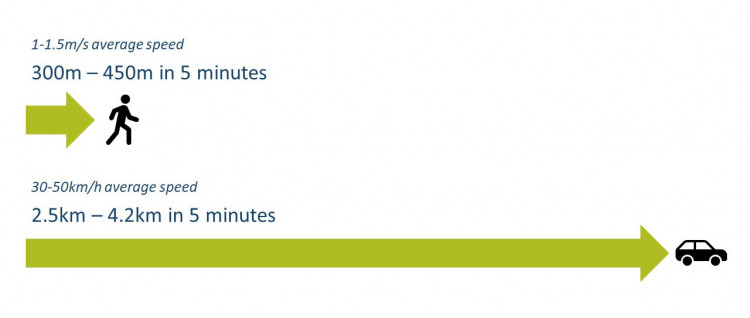Urban form relates to how communities are designed and structured, the type of development that is allowed and where, and how the different areas are connected. Urban form affects the need to travel and the attractiveness (or otherwise) of walking as a practical form of transport.
Three interrelated elements affect whether urban form is suitable for pedestrians – permeability, connections to destinations and density which are discussed in the table below.
Table: Important elements of urban form for pedestrians
|
Element |
Definition |
Typical approaches |
|
Pedestrian permeability |
The extent to which urban form permits ease of movement of people walking and avoids severance. Smaller block sizes or providing mid-block connections offer more route choices for people walking as explained on pg 47 of the Urban Street and Road Design Guide by Auckland Transport(external link). |
|
|
Connections to destinations |
The extent to which the walking network integrates with likely trip origins and destinations, including the public transport network. |
|
|
Density / compactness |
Concentrating land uses and activities brings them closer to each other, thus making distances more walkable. |
|
As pedestrians are the lowest speed mode, any deviation in their routes will inconvenience them more than other modes. Pedestrians benefit most from dense, permeable networks. A comparison of the average distance a pedestrian can travel in five minutes compared to a vehicle is illustrated in the photo below. This illustrates that the pedestrian network should be designed at a significantly finer grain than the vehicle movement network.

Average travel distance in five minutes for pedestrians compared with vehicles
Best practice urban design is focussed on compact urban form that features an interconnected street network with closely located employment, retail and neighbourhood centres, public transport connections, and open spaces. Walking is a viable travel option in these areas owing to the reduced distance between trip origins and destinations and because the road layout helps to reduce severance. The pedestrian network should be more permeable than the vehicle network, meaning that a pedestrian journey is shorter than one by car.
Off-street pedestrian networks can be the most enjoyable walking experiences if they are well-lit and public. That is, off-street paths should be safe for all people to use, day and night, without fear of being attacked. If well placed they can also reduce the distance travelled by those on foot. Good off-street connections avoid the need to walk alongside and across high-volume, high-speed roads where pedestrians are exposed to noise, air pollution, and the risk of being hit by a vehicle.
Good urban form can result in a high proportion of trips being made by pedestrians and people using micromobility and bicycles. Locating high-density residential, retail and other services around public transport interchanges provides options for longer distance trips that do not require a private motor vehicle. This can result in areas deliberately created with fewer cars and greater pedestrian activity.
Since many journeys start or end at home, the location of new housing and links to existing transport routes are particularly important. In some locations, pedestrians should be given a higher priority than other modes eg civic spaces should prioritise people over general traffic.
The function of roads and streets has traditionally been considered as primarily the movement of people and goods along a route, with the on-street activity function of roads and streets being secondary, if considered at all.
A ‘Movement and place’ approach (also known as ‘Link and place’) brings on-street activity together with adjacent land use and the movement function of transport. It can contribute to walkability through better consideration of the different roles a street plays.
‘Place’ in this context is defined as where
a street is a destination in its own right: a location where activities occur on or adjacent to the street, and where the buildings and spaces may have a social or cultural significance in their own right [1].
Adjacent land use has an impact on place through generation of on-street activity and movement through its requirement for access. On street activity also generates lateral movement across the carriageway, impacting on the movement of traffic. The photo below shows a street with a high place function and a low movement function.

Civic Space, Darby Street, Auckland (Jeanette Ward)
The One Network Framework applies a movement and place approach to classifying NZ’s road network.
Further information on the ONF relevant to planning for pedestrians can be found in Data sets and tools of the Planning methods sections.
PNG: Data sets and tools: One Network Framework
To learn how the movement and place approach translates into design, refer to the Streets and Places section of the PNG and also the Aotearoa Urban Street Design Guide.
Aotearoa urban street planning and design guide
To learn more about the classification of movement and place within the One Network Framework, refer to:
[1] Austroads. (2020). Classifying, Measuring and Valuing the Benefits of Place on the Transport System(external link), AP-R626-20